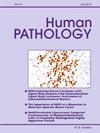缺乏CTNNB1突变的具有毛基质样特征的高级别子宫内膜样癌:临床病理特征和新的分子事件
IF 2.6
2区 医学
Q2 PATHOLOGY
引用次数: 0
摘要
背景:毛基质样高级别子宫内膜样癌(PiMHEC)是最近发现的一种侵袭性子宫内膜癌。先前的报道将PiMHEC与CTNNB1外显子3突变和核β-catenin异常表达联系起来。目的通过分析3例缺乏CTNNB1突变和β-catenin核积累的新病例,扩大对PiMHEC潜在亚分类的认识。目的:对3例具有毛基质样特征的高级别子宫内膜样癌的临床表现和病理特征进行分析。免疫组织化学(IHC)和靶向下一代测序(NGS)。结果所有肿瘤均表现出两种成分:高级别基底样细胞成分,包括非典型基底样细胞、地理坏死和局灶性“鬼影”细胞,以及相关的低级别FIGO 1级子宫内膜样癌成分。值得注意的是,这3例病例均未通过IHC检测到细胞核β-catenin表达,且均缺乏CTNNB1外显子3突变。尽管如此,肿瘤符合先前研究中描述的PiMHEC的形态学标准,并表现出侵袭性的临床行为。所有患者均表现为晚期疾病(IIC-IVB期),其中2例患者在12个月内复发。NGS在任何情况下都没有发现CTNNB1突变,但发现了其他可能的致癌改变:一个肿瘤含有FGFR4 p.T259A突变,两个肿瘤有致病性TSC2突变,一个肿瘤有KRAS p.G12D突变,两个肿瘤显示MYC扩增,以及其他遗传变化。结论具有毛基质样特征的高级别子宫内膜样癌缺乏CTNNB1突变,可能是PiMHEC的一个潜在亚型,表现出侵袭性行为。CTNNB1野生型病例似乎依赖于其他致癌驱动因素,这表明CTNNB1突变可能不是PiMHEC表型的绝对要求。本文章由计算机程序翻译,如有差异,请以英文原文为准。
High-grade endometrioid carcinomas with pilomatrix-like features lacking CTNNB1 Mutations: Clinicopathologic characteristics and novel molecular events
Context
Pilomatrix-like high-grade endometrioid carcinoma (PiMHEC) represents a recently described, aggressive variant of endometrial carcinoma. Prior reports have linked PiMHEC with CTNNB1 exon 3 mutations and abnormal nuclear β-catenin expression.
Objective
We aimed to expand the understanding a potential subclassification of PiMHEC by analyzing three new cases that lack CTNNB1 mutations and β-catenin nuclear accumulation.
Design
Three cases of high-grade endometrioid carcinomas with pilomatrix-like features were identified and their clinical presentations and pathologic features reviewed. Immunohistochemistry (IHC) and targeted next-generation sequencing (NGS) were performed.
Results
All tumors demonstrated two components: a high-grade basaloid component with solid sheets of atypical basaloid cells, geographic necrosis, and focal “ghost” cells, and an associated low-grade FIGO grade 1 endometrioid carcinoma component. Notably, none of the three cases showed nuclear β-catenin expression by IHC, and all lacked CTNNB1 exon 3 mutations. Despite this, the tumors fulfilled the morphologic criteria for PiMHEC described in prior studies and displayed aggressive clinical behavior. All the patients presented with advanced-stage disease (stages IIC–IVB), and two patients had a recurrence within 12 months. NGS revealed no CTNNB1 mutations in any case, but identified alternative likely oncogenic alterations: one tumor harbored an FGFR4 p.
T259A mutation, two tumors had pathogenic TSC2 mutations, one had a KRAS p.G12D mutation, and two showed MYC amplification, among other genetic changes.
Conclusions
High-grade endometrioid carcinomas with pilomatrix-like features lacking CTNNB1 mutations may represent a potential subclassification of PiMHEC, which exhibit aggressive behavior. CTNNB1-wildtype cases appear to rely on alternative oncogenic drivers, indicating that CTNNB1 mutation maybe not an absolute requirement for the PiMHEC phenotype.
求助全文
通过发布文献求助,成功后即可免费获取论文全文。
去求助
来源期刊

Human pathology
医学-病理学
CiteScore
5.30
自引率
6.10%
发文量
206
审稿时长
21 days
期刊介绍:
Human Pathology is designed to bring information of clinicopathologic significance to human disease to the laboratory and clinical physician. It presents information drawn from morphologic and clinical laboratory studies with direct relevance to the understanding of human diseases. Papers published concern morphologic and clinicopathologic observations, reviews of diseases, analyses of problems in pathology, significant collections of case material and advances in concepts or techniques of value in the analysis and diagnosis of disease. Theoretical and experimental pathology and molecular biology pertinent to human disease are included. This critical journal is well illustrated with exceptional reproductions of photomicrographs and microscopic anatomy.
 求助内容:
求助内容: 应助结果提醒方式:
应助结果提醒方式:


